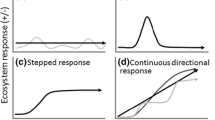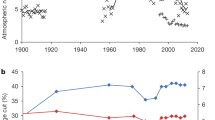Abstract
Biodiversity is thought to be essential for ecosystem stability, function and long-term sustainability. Since nitrogen is the limiting nutrient for plant growth in many terrestrial ecosystems, reactive nitrogen has the potential to reduce the diversity of terrestrial vegetation and associated biota through favouring species adapted to quickly exploiting available nutrients. Although the potential has long been recognised, only recently has enough evidence come together to show beyond reasonable doubt that these changes are already occurring. Linked together, experimental, regional/empirical, and time-series research provide a powerful argument that enhanced deposition of reactive nitrogen across Great Britain, and potentially the rest of Europe, has resulted in a significant and ongoing decline in grassland species richness and diversity.
Similar content being viewed by others
References
Grime, J. P., Plant Strategies and Vegetation Processes, London: Wiley, 1979.
Phoenix, G. K., Booth, R. E., Leake, J. R. et al., Effects of enhanced nitrogen deposition and phosphorus limitation on nitrogen budgets of semi-natural grasslands, Global Change Biology, 2003, 9: 1309–1321.
Power, S. A., Ashmore, M. R., Cousins, D. A., Impacts and fate of experimentally enhanced nitrogen deposited on a British Lowland Heath, Environmental Pollution, 1998, 102: 27–34.
Brunsting, A. M. H., Heil, G. W., The role of nutrients in the interactions between a herbivorous beetle and some competing plant species in heathlands, Oikos, 1985, 44: 23–26.
Tilman, D., Secondary succession and the pattern of plant dominance along experimental nitrogen gradients, Ecological Monogrographs, 1987, 57: 189–214.
Reich, P. B., Knops, J., Tilman, D. et al., Plant diversity enhances ecosystem responses to elevated CO2 and nitrogen deposition, Nature, 2001, 410: 809–812.
Goulding, K. W. T., Bailey, N. J., Bradbury, N. J. et al., Nitrogen deposition and its contribution to nitrogen cycling and associated soil processes, New Phytologist, 1998, 139: 49–58.
EMEP (Co-operative Programme for Monitoring and Evaluation of the Long-Range Transmission of Air pollutants in Europe), Transboundary Acidification and Eutrophication in Europe. Research Report no. 101, Norwegian Meterological Institute, 2000.
Dise, N. B., Matzner, E., Gundersen, P., Synthesis of nitrogen pools and fluxes from European forest ecosystems, Water, Air and Soil Pollution, 1998, 105: 143–154.
NEGTAP (National Expert Group on Transboundary Air Pollution), Transboundary air pollution: Acidification, eutrophication and ground-level ozone in the UK, Edinburgh, 2001.
Bouwman, A. F., van Vuuren, D. P., Derwent, R. G. et al., A global analysis of acidification and eutrophication of terrestrial ecosystems, Water, Air and Soil Pollution, 2002, 141: 349–382.
Bobbink, R., Hornung, M., Roelofs, J. G. M., The effects of airborne nitrogen pollutants on species diversity in natural and seminatural European vegetation, Journal of Ecology, 1998, 86: 717–738.
Revenga, C., Murray, S., Abramovitz, J. et al., Watersheds of the World: Ecology and Vulnerability, Washington DC: World Resources Institute, 1998.
Watkinson, A. R., Ormerod, S. J., Grasslands, grazing and biodiversity: Editors’ introduction, Journal of Applied Ecology, 2001, 38: 233–237.
Thomas, J. A., Telfer, M. G., Roy, D. B. et al., Comparative losses of British butterflies, birds and plants and the global extinction crisis, Science, 2004, 303: 1879–1881.
Ratcliffe, D. A., A Nature Conservation Review, Cambridge: Cambridge University Press, 1977.
Woodin, S. J., Farmer, A. M., Impacts of sulphur and nitrogen deposition on sites and species of nature conservation importance in Great Britain, Biological Conservation, 1993, 63: 23–30.
Jenkinson, D. S., Potts, J. M., Perry, J. N. et al., Trends in herbage yields over the last century on the Rothamsted long-term continuous hay experiment, Journal of Agricultural Science, 1994, 122: 365–374.
Johnson, A. E., Goulding, K. W. T., Poulton, P. R., Soil acidification during more than 100 years under permanent grassland and woodland at Rothamsted, Soil Use and Management, 1986, 2: 3–10.
Mountford, J. O., Lakhani, K. H., Kirkham, F. W., Experimental assessment of the effects of nitrogen addition under hay-cutting and aftermath grazing on the vegetation of meadows on a Somerset peat moor, Journal of Applied Ecology, 1993, 30: 321–332.
Kirkham, F. W., Kent, M., Soil seed bank composition in relation to the above-ground vegetation in fertilized and unfertilized hay meadows on a Somerset peat moor, Journal of Applied Ecology, 1997, 34: 889–902.
Kirkham, F. W., Wilkins, R. J., The productivity and response to inorganic fertilizers of species rich wetland hay meadows on the Somerset moors: Nitrogen response under hay cutting and aftermath grazing, Grass and Forage Science, 1994, 49: 152–162.
Kirkham, F. W., Mountford, J. O., Wilkins, R. J., The effects of nitrogen, potassium and phosphorus addition on the vegetation of a Somerset peat moor under cutting management, Journal of Applied Ecology, 1996, 33: 1013–1029.
Morecroft, M. D., Sellers, E. K., Lee, J. A., An experimental investigation into the effects of atmospheric deposition on two semi-natural grasslands, Journal of Ecology, 1994, 82: 475–483.
Carroll, J. A., Caporn, S. J. M., Johnson, D. et al., The interactions between plant growth, vegetation structure and soil processes in semi-natural acidic and calcareous grasslands receiving long-term inputs of simulated pollutant nitrogen deposition, Environmental Pollution, 2003, 121: 363–376.
Tilman, D., Wedin, D., Knops, J., Productivity and sustainability influenced by biodiversity in grassland ecosystems, Nature, 1996, 379: 718–720.
Wedin, D. A., Tilman, D., Influence of nitrogen loading and species composition on the carbon balance of grasslands, Science, 1996, 274: 1720–1723.
Stevens, C. J., Dise, N. B., Mountford, J. O. et al., Impact of nitrogen deposition on the species richness of grasslands, Science, 2004, 303: 1876–1879.
Aerts, R., Berendse, F., de Caluwe, H. et al., Competition in heathland along an experimental gradient of nutrient availability, Oikos, 1990, 57: 310–318.
Nilsson, J., Grennfelt, P., Critical Loads for Sulphur and Nitrogen, NORD 1988:15, Copenhagen: Nordic Council of Ministers, 1988.
Achermann, B., Bobbink, R., Empirical critical loads for nitrogen, Environmental documentation no 164, Berne: Swiss Agency for the Environment, Forests and Landscape, 2003.
Heil, G. W., Diemont, W. H., Raised nutrient levels change heathland into grassland, Vegetatio, 1983, 53: 113–120.
DEFRA (Department of Environment, Food and Rural Affairs), A Biodiversity Strategy for England. Measuring Progress: Baseline Assessment, London: Department for Environment, Food and Rural Affairs, 2003.
Ellenberg, H., Weber, H. E., Dull, R. et al., Zeigerwerte von Pflanzen in Mitteleuropa, Scripta Geobotanica, 1991, 18: 1–248.
Hill, M. O., Roy, D. B., Mountford, J. O. et al., Extending Ellenberg’s indicator values to a new area: an algorithmic approach, Journal of Applied Ecology, 2000, 37: 3–15.
Smart, S. M., Robertson, J. C., Shiels, E. J.. et al., Locating eutrophication effects across British vegetation between 1990 and 1998, Global Change Biology, 2003, 9: 1763–1774.
Author information
Authors and Affiliations
Corresponding author
Rights and permissions
About this article
Cite this article
Dise, N.B., Stevens, J. Nitrogen deposition and reduction of terrestrial biodiversity: Evidence from temperate grasslands. Sci. China Ser. C.-Life Sci. 48 (Suppl 2), 720–728 (2005). https://doi.org/10.1007/BF03187112
Received:
Issue Date:
DOI: https://doi.org/10.1007/BF03187112




